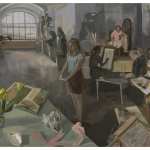
Contributed by Gabriel Fine / It seems oddly fitting that the exhibition �God Made My Face: A Collective Portrait of James Baldwin� begins not with Baldwin�s face but with his eye. Hilton Als, the writer and New Yorker critic who curated this masterful show at David Zwirner, is quick to remind us that the show exists on account of Baldwin�s incisive vision. The first room displays Baldwin�s doodle of a woman, photographs of asphalt and vacant Paris doorways, and a canvas by Beauford Delaney, who galvanized Baldwin�s faith in black artists. These are the people, the geography, and the art that Baldwin observed, and it was his observations that made him legendary. Yet Als also cautions in the show�s press release that in Baldwin�s conventional hagiography �much gets erased about the great artist.� Exploring his representation in the visual arts can help reveal the nuance, complexity, and limitations of the literary icon.

Some of the portraiture straightforwardly captures the personal side of Baldwin�s politicized life. Richard Avedon�s photographs show his face morphing from an awkward grimace to an exuberant laugh at his mother�s arm, while poignant letters illuminate Baldwin�s early skill on the page and a turntable loops a recording of him singing a gospel traditional. But the show�s painted works offer some of its most extraordinary insights. Delaney�s Dark Rapture, arguably the pi�ce de r�sistance, depicts a naked Baldwin in a pastoral scene composed of luminous colors and brushwork reminiscent of Henri Matisse.



This vibrant and erotic coloration is connected to another focus of the show: Baldwin�s �sexuality and aestheticism.� These qualities are essential to understanding him, even though the writer downplayed them during his life. Though some of Baldwin�s seminal works, like Giovanni�s Room and the essay �Here Be Dragons,� addressed issues of masculinity, the civil rights movement he participated in was notably heteronormative and until recently his homosexuality has been substantially ignored. Glenn Ligon�s playful and acerbic painted prints explore this phenomenon, smearing clownish colors over black icons like Othello and Frederick Douglass and giving Malcolm X rouge and lipstick.




Much of �God Made My Face� examines the historical factors that shaped Baldwin�s identity and idolization, from harrowing photographs of nameless black men at the gallows to massive steel railroad tracks and pop culture stars. In one of the most powerful and surprising aspects of the show, extending beyond but remaining congruent with Baldwin�s life, a young Michael Jackson is haunted by his disfigured shadow. The exhibition�s symbolic finale, a multimedia collage by Njideka Akunyili Crosby, illustrates how myriad cultural influences are incarnated not only in Baldwin�s life but also in black men and women in general. A woman bends over a chair to hug a man, personifying what Baldwin wrote in The Fire Next Time: �Love takes off the masks we fear we cannot live without and know we cannot live within.� �God Made My Face� offers a beautiful, deeply compassionate look behind Baldwin�s mask, uncovering a complicated and brilliant human being.
�God Made My Face: A Collective Portrait of James Baldwin,� curated by Hilton Als. David Zwirner, Chelsea, New York, NY. Through February 16, 2019.
About the author: Gabriel Fine is a writer from Colorado who currently lives in Brooklyn. He has written for Slant Magazine and Denver Westword and has poetry forthcoming in Image. Follow Fine on Twitter @_gabrielfine_
Related posts:
Presidents� Day video: The unveiling of the official Obama portraits
Web world: The New Museum�s 2015 Triennial
Didier William: The unblinking eye
Art and film: �Detroit� and Faulkner�s truth














�…Beauford Delaney, who galvanized Baldwin�s faith in black artists.�
Galvanized? Help me out here.
Dictionary definition: Verb: jolt, shock, startle, impel, stir, spur, prod, urge, motivate, stimulate, electrify, excite, rouse, arouse, awaken; invigorate, fire, animate, vitalize, energize, exhilarate, thrill, catalyze, inspire, light a fire under; informal give someone a shot in the arm.
One artist � Delaney, �stirred him to action� (galvanized) Baldwin�s faith in black artists. Okay, so Delaney was his epiphany moment in which he suddenly realized he had faith in black artists. Prior to that he had no faith in black artists, including himself.
I just received a note from author Gabe Fine responding to Billy Evans� comments:
My line about “galvanizing” Baldwin’s faith in black artists largely came from this quotation:
“Beauford was the first walking, living proof, for me, that a black man could be an artist. In a warmer time, a less blasphemous place, he would have been recognized as my Master and I as his Pupil. He became, for me, an example of courage and integrity, humility and passion. An absolute integrity: I saw him shaken many times and I lived to see him broken but I never saw him bow.” � James Baldwin in his introduction to The Price of the Ticket, 1985
Thanks for reading.
Thank you for clarifying this point. Your quote does show the verb warranted.
My critique then falls to James Baldwin. One would simply ask if he ever listened to black music prior to contact with Beauford.
Maybe he is just being melodramatic?
I do not wish to nitpick but words do matter, and that leapt off the page.